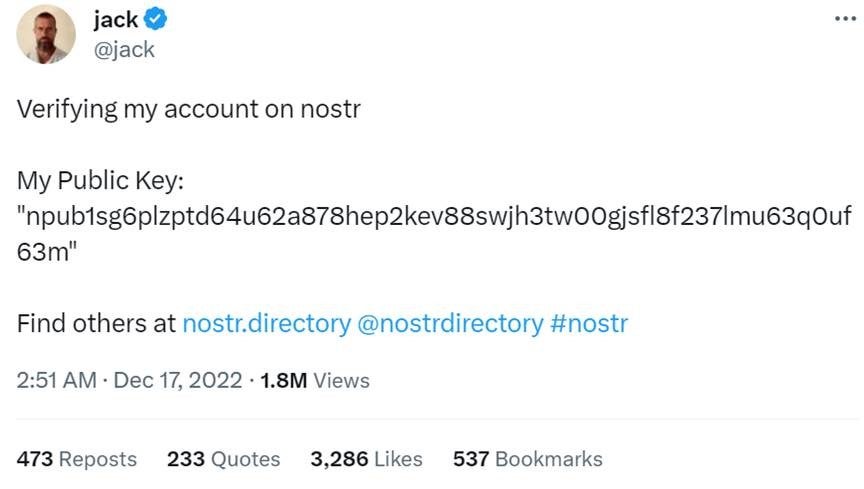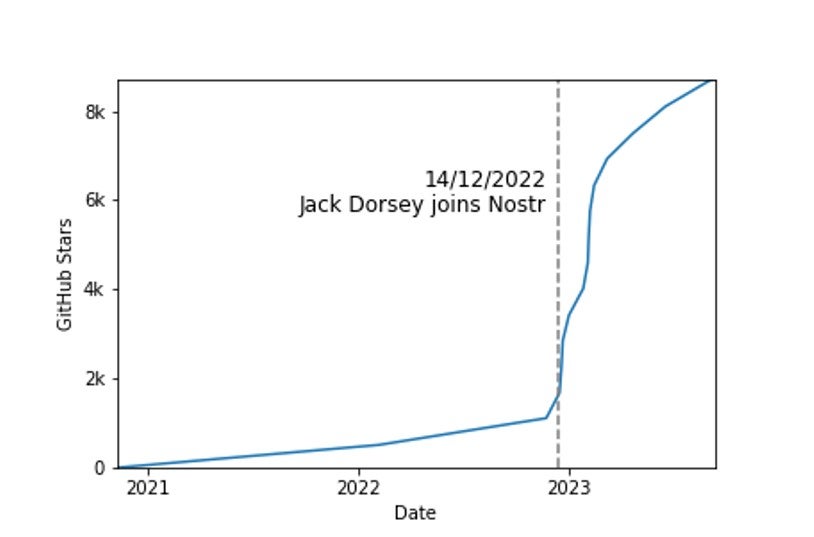In 2020, developers began working on Nostr, an open protocol for building interoperable social media platforms.
Growing concerns over data privacy, censorship, and troll farms undermining the integrity of online conversation on X (formerly Twitter) have led to a surge in new decentralized microblogging platforms that benefit from using cryptography to verify the source of content.
Jack Dorsey, founder of Twitter and board member of competing platform, BlueSky, even donated 14 BTC ($245000) to fund the development of Nostr, while promoting the platform by featuring “#nostr” along with his ‘npub’ (his Nostr username) in his X bio.

What is Nostr?
Nostr is short for ‘Notes and Other Stuff Transmitted by Relays’. Rather than being a product in direct competition with X, Nostr is an open protocol on which social media platforms can be built. Nostr could become as widespread as HTTP for the web or SMTP for email.
Users interact with the Nostr protocol via apps known as clients. Just as someone using Outlook can receive an email from somebody using Gmail, a user of one Nostr client can interact with the users of another. Users can even switch clients without losing their identities and followers.
Relays are the backend servers of the protocol. As the name suggests, they relay messages between clients. Anyone can run a relay. Users can choose which and how many relays they use—there are currently over 800 relays to choose from according to Nostr monitoring site nostr.watch. The absence of a central server gives Nostr censorship-resistant properties.
How well do you really know your competitors?
Access the most comprehensive Company Profiles on the market, powered by GlobalData. Save hours of research. Gain competitive edge.

Thank you!
Your download email will arrive shortly
Not ready to buy yet? Download a free sample
We are confident about the unique quality of our Company Profiles. However, we want you to make the most beneficial decision for your business, so we offer a free sample that you can download by submitting the below form
By GlobalDataHow does Nostr work?
Under the hood, clients publish ‘events’to relays, which then pass these on to subscribing clients. Clients can both publish and subscribe to multiple relays, making for a resilient network.
Rather than a username stored on a central server, which only works for one platform, users are identified by a cryptographic key pair. Users can use the same key pair across clients of Nostr while maintaining their digital identity.
Each event contains content along with some metadata, in particular, each event includes a digital signature made by the creator’s private key. The integrity of events can then be cryptographically verified by the client using the publisher’s public key.
Who is building Nostr?
Like Nostr, the Jack Dorsey-backed BlueSky is building a protocol upon which the invite-only social media is built, namely the AT protocol. The main difference between BlueSky’s AT protocol and Nostr is their approach to development. BlueSky has opted for a top-down, closed approach whereas the development of Nostr heavily leans towards open source and open collaboration. The simplified design of Nostr also makes it much more accessible to developers when compared to the AT protocol.

The protocol itself has over 100 contributors and has over 8,000 stars on GitHub. There are also dozens of clients across all platforms (iOS, Android, Web) and many more relay implementations. Jack Dorsey’s endorsement is likely a contributing factor in the high developer activity as depicted in the above chart.
Primal – a slick Nostr experience
Primal, a technology company building on Nostr, raised $1 million in seed funding in July 2023 led by Ten31 and Hivemind. Primal is building both a client and relay for Nostr and it offers a sleek user interface that will feel familiar to X users, along with faster load times thanks to its caching service. It has over 500k users with over 67 million notes—the Nostr counterpart to what used to be known as a ‘tweet’ on X/Twitter.
The future of Nostr
Since the protocol is so flexible, applications other than microblogging can be built upon it, from video hosting to the Google Forms alternative formstr. There are over 700 open-source projects tagged with the Nostr topic on GitHub.
However, as the platform grows, running a relay becomes more resource-intensive, and questions over financial backing will have to be addressed—perhaps by micropayments.
Furthermore, a lack of more sophisticated key management—while easy to work with for developers—may cause havoc in the future. A leaked private key gives an attacker full control over an account including access to direct messages and, unlike with a centralized platform, the protocol lacks a reset password function.
From a technical perspective, it will be exciting to see whether Nostr flourishes or whether it runs into scaling issues and limitations due to its simplicity. Equally, the reaction of industry incumbents such as Meta and X remains to be seen.







